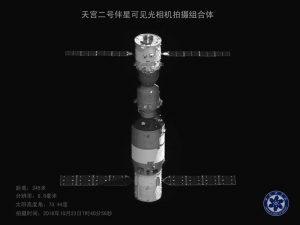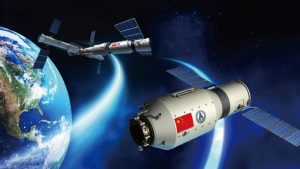
Shenzhou-11 crew consists of two male astronauts, veteran space traveler, Jing Haipeng (left) and newcomer to space, Chen Dong.
Crew photos: ChinaSpaceflight.com
Two Chinese astronauts have entered the Shenzhou-11 reentry module to prepare for their return to the Earth.
Space travelers Jing Haipeng and Chen Dong have lived and worked in the Tiangong-2 space lab for 30 days, the longest stay in Earth orbit by Chinese astronauts.
Separation process
Prior to the separation of Shenzhou-11 with the space lab, the astronauts transferred experimental devices and items from Tiangong-2 to the spacecraft’s re-entry module.
“The entire separation process was very smooth. Both Tiangong and the spacecraft completed their designated moves, and the process to start operation was quite normal,” reported Chen Xianfeng, director of overplan office of Beijing Aerospace Control Center.
Status check
In an interview with CCTV-Plus, Chen added that during the course of separation, the 30-meter stop, the 120-meter stop, the final separation and the move for spacecraft to reset flight, “all the moves were very good.”
“Both Tiangong and Shenzhou are in a normal state at present and various missions are going smoothly,” said Chen.
After the separation, Shenzhou-11 is scheduled to fly to a position 120 meters away from Tiangong-2. Once at that distance, the two-person craft will stay in orbit until ground control teams evaluate its status, and then give the final go for the crew to gradually depart the neighboring space lab.

Image snagged by the Banxing-2 microsatellite that was deployed from the Tiangong-2 shows Shenzhou-11 (above) and Tiangong-2 docked in orbit on October 23, 2016.
Credit: Chinese Academy of Sciences via GBTimes
Reentry point
“Tonight we will conduct an orbit control to the spacecraft to take aim at the re-entry point, because after the separation, there will be a separating force between the spacecraft and Tiangong, which will cause a tiny deviation from the orbit. We have to readjust to make the re-entry control more accurate,” explained Chen to CCTV-Plus.
Around one day later, the re-entry module will descend from an orbit about 244 miles (393 kilometers) above Earth.
The spacecraft is expected to touch down in the Siziwang Banner in north China’s Inner Mongolia Autonomous Region.
The Tiangong-2 space lab is remaining in its orbit, carrying out remote experiments.
In April 2017, China’s first cargo spacecraft – the Tianzhou-1 — will be launched via a Long March 7 to dock with the space lab.
For video views of the Shenzhou-11 crew preparing for reentry to Earth, go to:
http://l3-pv.news.cctvplus.com/2016/1117/8036789_Preview_1479386963751.mp4



